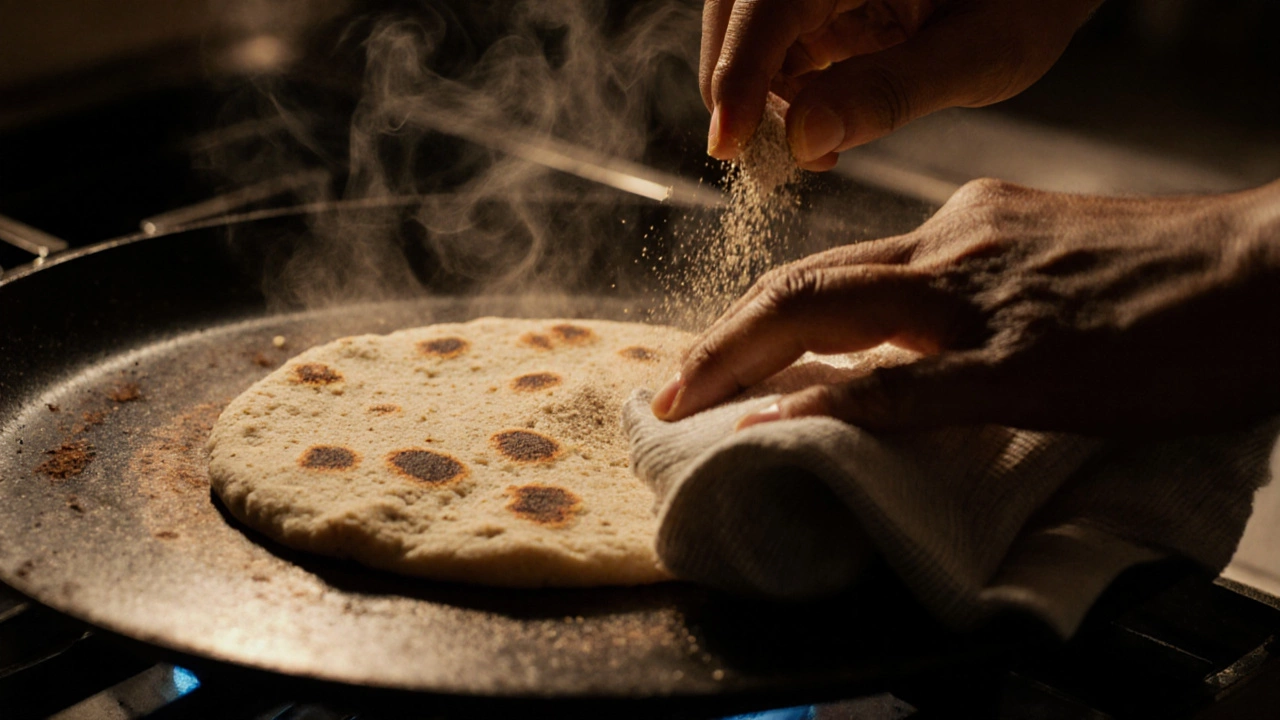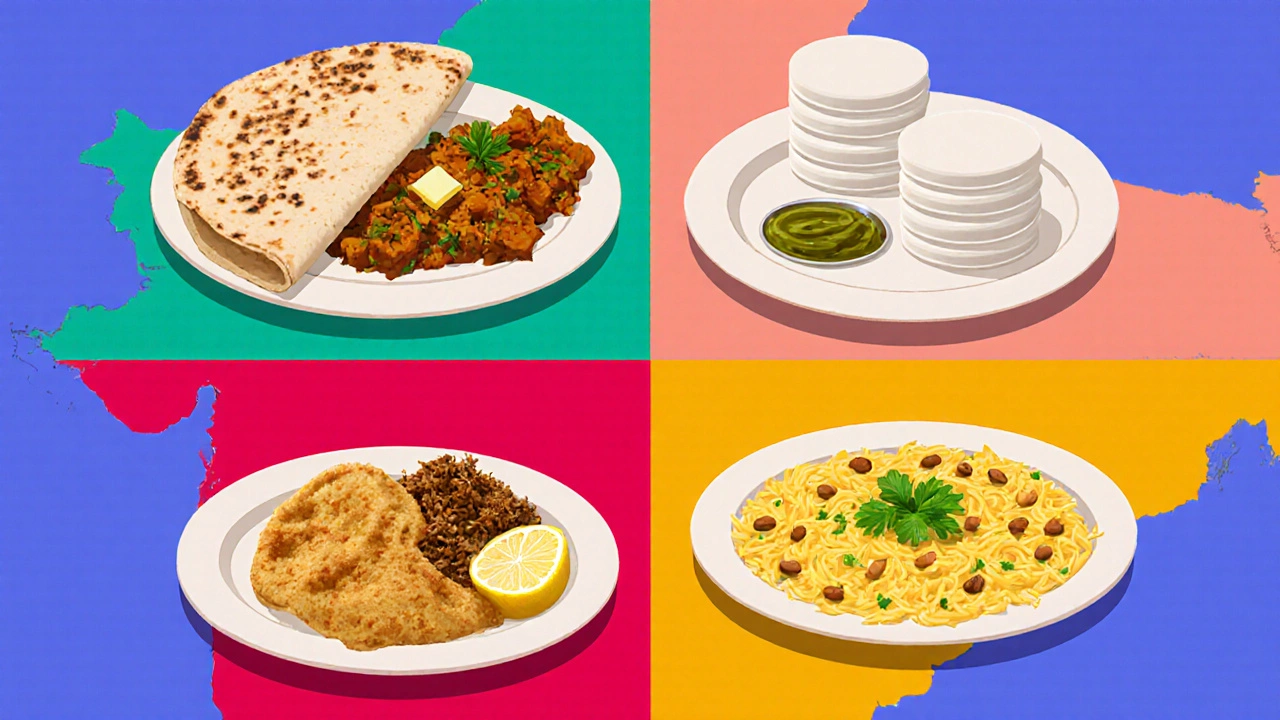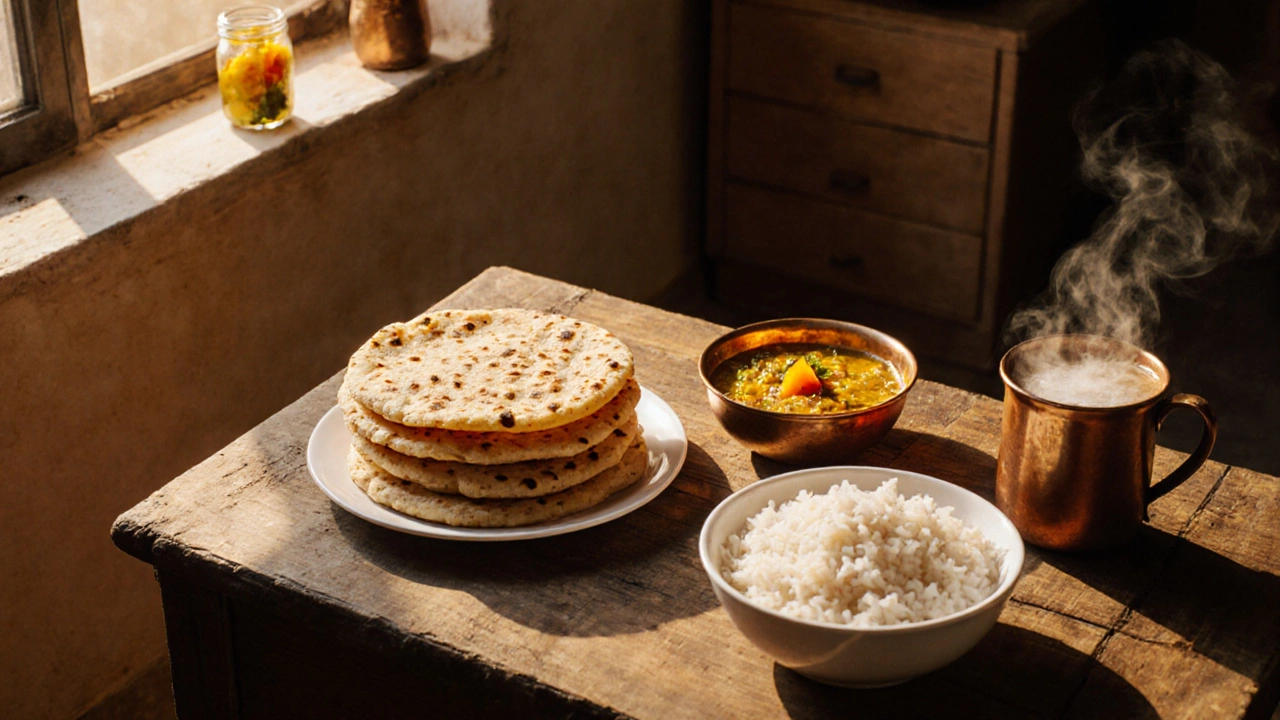Roti vs. Rice Nutrition Calculator
Roti (Whole Wheat)
Based on average Indian consumption data
Rice (White, Boiled)
Based on average Indian consumption data
Nutrition Comparison
When you ask anyone from India what they grab for a quick breakfast, the answer almost always points to a simple flatbread or a bowl of steaming rice. Those two items dominate daily tables across the subcontinent, making them the undisputed most eaten Indian food. In this guide we’ll break down why they rule the kitchen, how regional habits shape their consumption, and give you fast‑track recipes to bring a taste of India to your own breakfast routine.
How We Measure "Most Eaten"
To decide which dish truly tops the list we looked at three data points:
- National household consumption surveys from the Ministry of Statistics and Programme Implementation (2023‑24) that track grams per capita per day.
- Market research on sales volume of wheat flour (atta) versus rice, the two primary raw materials.
- Street‑level observations in five major metros - Delhi, Mumbai, Kolkata, Chennai, and Bangalore - over a two‑week period.
All three sources point to a clear winner: the wheat‑based flatbread known as Roti a thin, unleavened round made from whole‑wheat flour (atta) cooked on a hot griddle (tava). On average, an Indian adult consumes about 180 grams of roti each day - roughly three to four pieces - outpacing rice by a narrow margin.
Roti (Chapati): The Daily Staple
Roti, often called chapati in many regions, is more than just a side dish; it’s a cultural anchor. Made from Atta whole‑wheat flour milled from high‑gluten wheat, the dough is rolled into 6‑8 cm circles and cooked on a hot tava until puffy. The puff indicates air trapped inside, creating a soft yet slightly crisp texture that’s perfect for scooping up lentils, vegetables, or meat curries.
Key attributes of roti:
- Average calorie count: 120 kcal per 50 g piece.
- Preparation time: 5‑7 minutes for a batch of 4‑6 pieces.
- Regional variations: In Punjab, it’s often brushed with ghee; in Gujarat, a pinch of sugar is added for a subtle sweet note.
Because it requires only flour, water, and a pinch of salt, roti fits perfectly into busy mornings. A typical Indian household will have a stack of rotis ready by the time the sun rises, especially in North India where wheat is the dominant grain.
Rice: The Close Rival
Rice holds the sixth‑largest share of daily grain consumption in India, especially in the South, East, and West Bengal. While roti leads in overall average grams per person, rice is the staple for over 300 million people who live in rice‑centric states like Tamil Nadu, Kerala, West Bengal, and Odisha.
Typical metrics for plain boiled rice:
- Average serving size: 150 grams (about one cup cooked).
- Calorie count: 190 kcal per serving.
- Cooking time: 12‑15 minutes in a pressure cooker or rice cooker.
Rice often appears as the base for dishes like idli, dosa batter, or simple lemon rice, making it versatile for breakfast, lunch, and dinner.
Regional Flavors Influence the Breakfast Table
India’s culinary map is a patchwork of climate, agriculture, and tradition. Here’s a quick look at how the top two staples shape breakfast across the country:
| Region | Primary Staple | Typical Breakfast Dish | Average Daily Intake (grams per person) |
|---|---|---|---|
| North (Punjab, Haryana, Delhi) | Roti | Paratha with butter and pickle | 210 |
| West (Maharashtra, Gujarat) | Roti/Rice | Poori with aloo sabzi / Poha | 180 (roti) / 150 (rice) |
| South (Tamil Nadu, Kerala, Karnataka) | Rice | Idli with sambar & chutney | 200 |
| East (West Bengal, Odisha) | Rice | Luchi with aloo dum | 190 |
Even in rice‑heavy states, many households keep a small stash of wheat flour to make occasional rotis for variety. Conversely, in wheat‑dominant areas, rice appears in the form of beaten rice (poha) or as a side for special occasions.

Quick Breakfast Recipes to Replicate the Indian Staples
Below are two lightning‑fast recipes that let you enjoy the most eaten Indian food without a full‑blown kitchen setup.
3‑Minute Roti (No‑Roll Method)
- Mix 1 cup Atta with ¼ cup water, a pinch of salt, and 1 tsp oil. Knead into a smooth ball (2‑3 minutes).
- Divide into 4 equal portions. Instead of rolling, press each ball between two parchment sheets with a heavy pan for 30 seconds - the dough spreads into a thin disc.
- Pre‑heat a non‑stick tava or skillet over medium‑high. Cook each disc for 20‑30 seconds, flip, and cook the other side until brown spots appear. Press gently with a cloth to puff.
- Serve immediately with a dollop of butter or alongside a quick Dal yellow split‑pea lentils cooked with turmeric and tempering.
Instant Microwave Rice (1‑Cup Version)
- Rinse 1 cup of basmati rice under cold water until water runs clear.
- Combine rice, 1 ½ cups water, a pinch of salt, and 1 tsp oil in a microwave‑safe bowl.
- Cover loosely and microwave on high for 5 minutes, stir, then microwave another 4‑5 minutes until water is absorbed.
- Fluff with a fork and top with a spoonful of Chai spiced Indian milk tea or a quick lemon‑coriander tadka.
Both recipes require minimal equipment and can be scaled up for larger families.
Nutritional Snapshot: Roti vs. Rice
Understanding the health angle can help you choose the right staple for your diet.
| Food | Calories | Protein | Fiber | Key Vitamins/Minerals |
|---|---|---|---|---|
| Roti (whole‑wheat) | 120 kcal | 4 g | 3 g | Iron, B‑complex |
| Rice (white, boiled) | 130 kcal | 2.5 g | 0.5 g | Magnesium, small amounts of B‑vitamins |
Roti offers more fiber and iron, while rice provides a quick source of energy with a softer texture for young children.
Quick‑Start Checklist for an Authentic Indian Breakfast
- Stock Atta and basmati rice in airtight containers.
- Keep a non‑stick tava or skillet for roti; a microwave‑safe bowl works for rice.
- Prepare a simple tempering: mustard seeds, curry leaves, and a pinch of asafoetida (hing) - it adds instant flavor to dal or rice.
- Have a side ready: plain yogurt, pickle, or a spoonful of ghee for richer taste.
- Serve hot; Indian breakfast is best enjoyed fresh and steaming.

Common Misconceptions About India’s Favorite Food
1It’s all about spices. While Indian cuisine is famous for spice blends, the most eaten foods are plain staples that act as vessels for those flavors.
2Only rice is Indian. Many assume rice defines Indian meals, but wheat‑based flatbreads dominate in the north and central belt.
3Breakfast is always heavy. A single roti with a spoon of curd can be a light start, especially in hotter climates.
From Street Stalls to Home Kitchens
Street vendors in Mumbai serve “pav bhaji” with buttered buns, but the underlying base is still a wheat product. In Chennai, the iconic “idli” is rice‑based, showing that even trendy street foods trace back to the same two grains.
Whether you’re chewing on a roti with spicy potato filling on a Delhi corner or sipping a bowl of rice congee in Kolkata, you’re part of a nationwide habit that fuels over a billion people each morning.
Takeaway: Why Roti Wins the Crown
Roti’s edge comes from three factors:
- Affordability - wheat is cheaper per kilogram than high‑quality rice in most wholesale markets.
- Portability - a soft roti can be rolled up with fillings for a grab‑and‑go snack.
- Culinary flexibility - it pairs equally well with dal, sabzi, meat curries, and even sweet spreads.
That said, India’s culinary diversity means rice still reigns supreme in southern kitchens. The two grains together form the backbone of Indian breakfasts, and understanding their roles helps you recreate authentic meals anywhere.
Which staple is more popular in urban India?
Urban north‑Indian households tend to eat more roti, while urban south‑Indian homes favor rice. Overall city‑wide data still shows roti edging out rice by about 5 % in total grams consumed.
Can I substitute whole‑wheat roti with multi‑grain versions?
Yes. Multi‑grain flour blends (adding millet, barley, or sorghum) retain the same cooking method and work well with traditional accompaniments, while boosting fiber.
How long can cooked roti be stored safely?
At room temperature, roti stays soft for up to 4 hours. Refrigerate in an airtight container for 2‑3 days; reheat on a dry skillet to restore fluffiness.
Is white rice or brown rice better for breakfast?
Brown rice offers more fiber and micronutrients, but white rice cooks faster and yields a softer texture that many prefer with curd or chutney in the morning.
What are common side dishes for roti at breakfast?
Typical sides include spiced lentil dal, potato bhaji, paneer tikka, plain yogurt, and various pickles. A quick squeeze of lemon can brighten the flavor.
